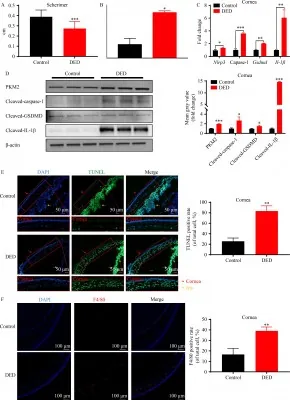
Groundbreaking Research Uncovers How Hyperosmolarity Drives Inflammation in Dry Eye Disease
2025-09-03
Author: Noah
Unlocking the Secrets of Dry Eye Disease
In a groundbreaking study led by researchers at the Zhejiang Provincial Engineering Institute on Eye Diseases, new insights into dry eye disease (DED) reveal how hyperosmolarity plays a pivotal role in inflammation and cellular damage. Published in the prestigious journal 'Frontiers of Medicine,' this research could pave the way for innovative treatments.
The Hidden Mechanisms Behind Dry Eyes
Dry eye disease is not just an inconvenience; it's a complex condition linked to the disruption of ocular surface homeostasis. The study unveils the intricate role of tear film hyperosmolarity, which triggers an inflammatory response in the corneal epithelial cells.
A Deep Dive into Cellular Interactions
Utilizing clinical samples from DED patients, the researchers discovered significant upregulation of glycolysis and pyroptosis-related genes such as PKM2 and GSDMD. This increase correlates with a surge in the inflammatory marker IL-1β, pointing to a direct link between hyperosmolarity and immune responses.
Unlocking Cellular Metabolism: The Role of Glycolysis
In vitro experiments showcased how macrophages and human corneal epithelial cells interact under hyperosmolar conditions. The findings suggest that the stressful microenvironment induces abnormal metabolic reprogramming in corneal cells, which in turn triggers inflammation in macrophages.
Potential Treatment on the Horizon: 2-Deoxy-d-Glucose
Remarkably, the researchers identified 2-Deoxy-d-glucose (2-DG) as a promising therapeutic agent. This compound was shown to inhibit glycolysis in corneal epithelial cells, leading to a reduction in macrophage pyroptosis and decreased inflammatory responses. Further, in vivo studies indicated that 2-DG could alleviate dry eye symptoms and diminish the overexpression of detrimental genes and proteins.
A Step Toward Better Dry Eye Treatments
In summary, this revolutionary study emphasizes the significance of hyperosmolar-induced glycolytic reprogramming in driving inflammation in dry eye disease. These findings open the door to potential new treatment strategies that could significantly improve the quality of life for millions suffering from DED.









 Brasil (PT)
Brasil (PT)
 Canada (EN)
Canada (EN)
 Chile (ES)
Chile (ES)
 Česko (CS)
Česko (CS)
 대한민국 (KO)
대한민국 (KO)
 España (ES)
España (ES)
 France (FR)
France (FR)
 Hong Kong (EN)
Hong Kong (EN)
 Italia (IT)
Italia (IT)
 日本 (JA)
日本 (JA)
 Magyarország (HU)
Magyarország (HU)
 Norge (NO)
Norge (NO)
 Polska (PL)
Polska (PL)
 Schweiz (DE)
Schweiz (DE)
 Singapore (EN)
Singapore (EN)
 Sverige (SV)
Sverige (SV)
 Suomi (FI)
Suomi (FI)
 Türkiye (TR)
Türkiye (TR)
 الإمارات العربية المتحدة (AR)
الإمارات العربية المتحدة (AR)